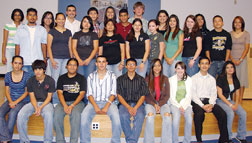Texas Program Puts High Schoolers on Engineering Express
 Photo:South Texas College High school students in Texas will earn college engineering credit before graduation.
|
A trailblazing program in Texas could become a national model for recruiting the next generation of engineers. At two campuses of South Texas College, high school students will earn a college-level associate’s degree in engineering before they even graduate.
The 18,400-student college’s “dual enrollment academy,” begun this fall, encourages high school juniors and seniors to go on to college to pursue industry careers and four-year engineering degrees. With financial support from the outside, students from 14 participating schools pay little or nothing for courses that will provide them with 66 college credits. The concept, approved by the state in 2003, was created to spur interest in medical science careers. Its quick success prompted formation of the engineering academy.
|
“We understand the importance of fostering interest in the fields of math, science and technology because these areas are driving the high-paying careers of today’s economy,” says Nick Gonzalez, South Texas College director of high school programs and services.
Participants in the two-year program, at the college’s McAllen and Westlaco campuses, undergo a competitive application process for admission. Candidates are evaluated on grades, coursework, extracurricular activities, resumes, and recommendations, among other things. Students accepted receive free books, tuition, tutoring and transportation. Area high schools defray 50% of tuition costs, plus books and transportation. The college underwrites the rest.
“There are many bright and talented students that have a real potential to pursue any field in engineering, but because of financial limitations or a lack of direction they lose interest or become intimidated,” Gonzalez says. “And that is where South Texas College steps in.”
The college secured a three-year, $560,000-grant earlier this month from the U.S. Dept. of Education for the academy, as well as $58,000 in state and local funding. Students take 14 to 15 credit hours per semester at a cost of about $1,000 for each credit hour. The college launched its inaugural engineering class this fall with 48 students, from 79 applicants. The demographic makeup is 95% Hispanic and 48% female.
“The focus of the grant is to assist predominantly minority institutions in effecting long-term improvement in science and engineering and increase the flow of underrepresented ethnic minorities into science and engineering careers,” says Luzelma Canales, the college’s grant development director.
Students are exposed to region-specific engineering disciplines such as industrial, manufacturing, civil, petroleum, and biomedical. Texas firms will post $2.2-billion in instate architecture and engineering billings this year, up 27.2% from 2005, according to McGraw-Hill Construction, of which ENR is a unit. The academy’s curriculum entails basic pre-engineering math, science and technology courses, as well as guest lecturers, seminars and summer internships. Students split their day between high school and the college.
“We want students to learn about other academic and work-force options that will give them the competitive edge to succeed,” says program coordinator Lupe Chavez. “We want them to be well informed about university admission requirements, scholarships, financial aid and housing opportunities when they transition from South Texas College to a four-year university.” Students and faculty will take field trips to several large Texas universities for a firsthand tour.
There still is concern from some in the industry that the program needs to balance academic learning with hands-on training. “We have not evolved the industry lag between education and application,” says Arnold Pedraza, owner of Utility Engineering Specialists, McAllen. “You can’t just read a book and learn it. But the dual enrollment program is a beginning.”
 Related Links:
Related Links: 
